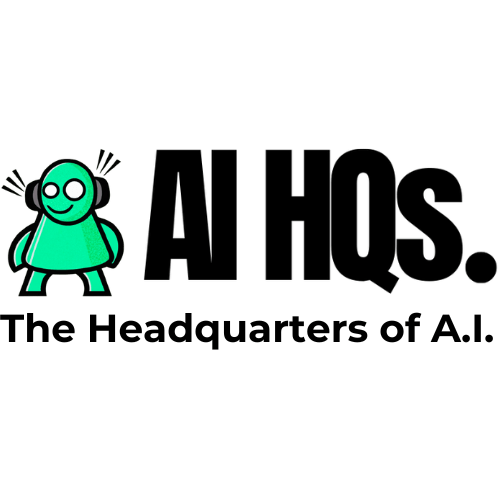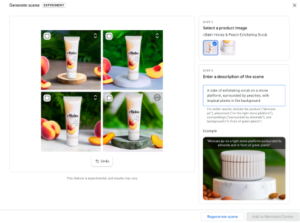Revolutionising Ad Creation: Amazon and Google’s AI-Powered Tools Transform the Marketing Landscape
In the ever-evolving world of digital marketing, two tech giants, Amazon and Google, are stepping up their game by harnessing the power of generative AI to help advertisers create stunning visuals, revamp product imagery, and simplify the creative process. In this blog, we’ll explore how these cutting-edge AI tools are changing the way brands promote their products and engage with their audience.
Amazon’s Innovative Approach
Amazon, the e-commerce juggernaut, is at the forefront of this marketing revolution. The company is beta testing an AI image generation tool designed to help advertisers create captivating backgrounds based on product descriptions and themes. This tool enables advertisers to upload a product image, describe the desired background, select a theme, and generate a captivating visual. The process is straightforward, allowing for quick and efficient ad creation.
Consider a scenario where a toaster needs to be showcased. With Amazon’s AI tool, you can envision it against a backdrop of a beautifully decorated kitchen table, adorned with autumn leaves and a bright orange pumpkin. While the beta tool may not be flawless, it offers convincing results, making product images truly stand out.
The true innovation lies in the ability to tell a compelling story through these images. No longer confined to standard product images with boring white backgrounds, advertisers can place their products in a lifestyle context that resonates with their target audience. According to Amazon, this tool can increase click-through rates by an impressive 40%.
But Amazon’s foray into generative AI doesn’t stop there. The company also introduced a tool to help sellers craft product descriptions and leverage the technology to summarize customer reviews. These advancements promise to streamline the advertising process and deliver a more immersive experience to customers.
Google Joins the Fray
Hot on Amazon’s heels, Google has announced its own generative AI product imagery tools for advertisers in the United States. Through its AI-powered Product Studio, businesses can now create product imagery at no additional cost, effectively reducing the need for expensive and time-consuming photoshoots. The concept is simple: by inputting a text prompt describing the desired image, merchants can generate new product visuals.
Product Studio offers a wide range of possibilities, from changing background colors to requesting specific scenes. For instance, a skincare company can request an image of a product “surrounded by peaches with tropical plants in the background” to convey a seasonal vibe. The AI model can also enhance low-quality images and remove distracting backgrounds, improving the overall quality of visuals.
This tool is a game-changer for businesses of all sizes, allowing them to create professional images for their ads without the usual costs associated with photography. It’s particularly advantageous for seasonal campaigns or themed advertisements, where reusing existing assets can save both time and money. In addition to Product Studio, Google is simplifying the process of setting up a product feed for businesses. Instead of manually inputting product details, Google’s Merchant Center Next can automatically populate the feed with information detected from a merchant’s website. This feature will help businesses save time and effort.
Google also aims to provide a better understanding of performance with all insights reports consolidated into the Performance tab. Businesses can review their best-selling products, monitor competitors, and gain insights into how shoppers engage with their listings on Search and Maps.
The introduction of generative AI tools by Amazon and Google is not only a significant development in the marketing world but also a glimpse into the future of advertising. These AI-powered tools are set to redefine the way advertisers create and present their products. Let’s dive deeper into the impact of this technological leap:
Revolutionizing Creativity: Generative AI allows advertisers to think beyond the conventional boundaries of product photography. Instead of being restricted to static images against plain backgrounds, advertisers can now conjure visually engaging scenes that resonate with their target audience. This newfound creativity can help brands tell captivating stories about their products, making them more relatable to consumers.
Cost-Efficiency: One of the most compelling aspects of these AI tools is their ability to save costs. Traditionally, creating captivating product images involved expensive photoshoots, location setups, and models. With generative AI, businesses can achieve professional-grade visuals without the associated expenses. This democratization of high-quality imagery benefits businesses of all sizes, particularly small and medium-sized enterprises.
Time-Saving: Time is of the essence in the fast-paced world of digital advertising. These AI tools offer a streamlined approach to image creation. By simply inputting a text prompt or description, advertisers can generate product imagery swiftly, eliminating the lengthy process of traditional photoshoots. The time saved can be channeled into refining ad strategies and focusing on other aspects of the marketing campaign.
Enhancing Image Quality: The AI models deployed by Amazon and Google can not only create images but also enhance existing ones. They have the capacity to improve the quality of low-resolution or subpar product images. This feature is invaluable for businesses looking to update their image catalog without investing in reshoots. Adapting to Seasonal Campaigns:Seasonal and thematic campaigns are a crucial part of marketing. These AI tools offer the flexibility to switch imagery according to the season, festivals, or themes, enabling businesses to stay relevant and eye-catching. For instance, a fashion brand can effortlessly transition from summer to winter collections without the need for a new photoshoot.
User-Generated Content: User-generated content (UGC) is a powerful marketing tool. These AI tools open the door for brands to leverage UGC effectively. By inputting descriptions provided by customers or feedback from social media, brands can create imagery that resonates with their loyal fanbase. Data-Driven Insights:AI tools not only assist in image creation but also provide data-driven insights. Advertisers can analyze the performance of various visuals, enabling them to make informed decisions on which images are most effective in driving customer engagement and conversion. This data-driven approach is a valuable asset in refining marketing strategies.
The Future of AI in Advertising
These initiatives from Amazon and Google mark a significant step forward in the world of advertising. The adoption of generative AI tools is poised to transform the marketing landscape, offering advertisers more creative freedom and efficiency in campaign creation. Brands are no longer limited to static product images; they can now weave compelling stories and set their products in diverse contexts. As both Amazon and Google continue to innovate, it’s clear that generative AI is here to stay. Advertisers will have to adapt to these powerful new tools to remain competitive in the digital marketing space. This wave of innovation not only simplifies the ad creation process but also promises to enhance the overall advertising experience for both brands and consumers.
In conclusion, the intersection of AI and advertising is opening up a world of possibilities, and the tools provided by Amazon and Google are just the beginning. Advertisers can look forward to more efficient, cost-effective, and creatively stimulating campaigns in the years to come. The future of advertising is now, and it’s driven by the power of generative AI.








